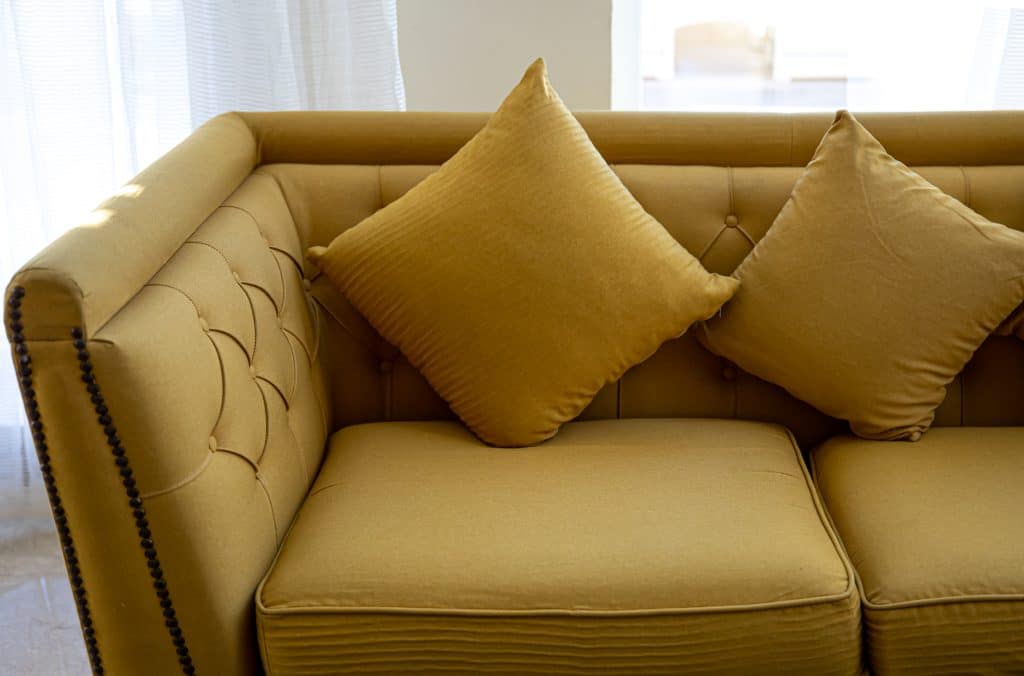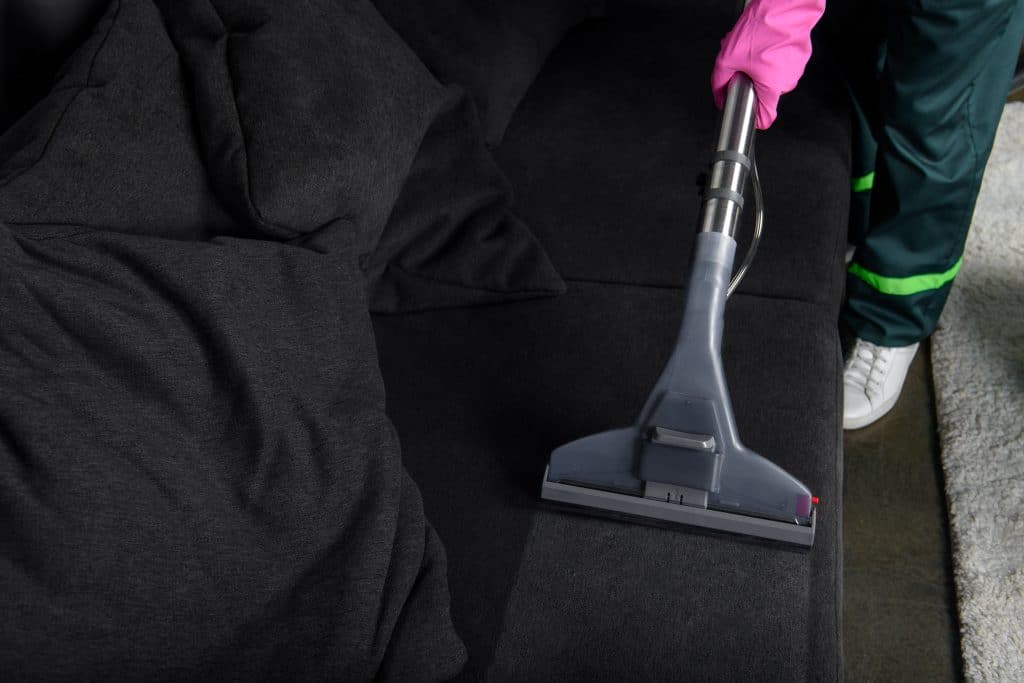Upholstery cleaning is an essential aspect of home maintenance that is often overlooked. Not only does it help to maintain the appearance and extend the life of your furniture, but it also helps to remove allergens and improve air quality in your home. Whether a homeowner or a business owner, understanding the basics is crucial to ensure that your furniture is cleaned and cared for properly. This comprehensive guide will explore everything you need to know about upholstery cleaning, from the types of upholstery to the best cleaning methods!
What Is Upholstery Cleaning?

Upholstery cleaning removes dirt, dust, and other contaminants from the surface of upholstered furniture. This can include sofas, chairs, loveseats, cushions, and pillows. Upholstery cleaning can be performed using various methods, including steam cleaning, dry cleaning, spot cleaning, foam cleaning, and chemical cleaning. The method used will depend on the type of upholstery and the type of contaminants that need to be removed.
Types Of Upholstery

Before diving into the cleaning process, it’s essential to understand the different types of upholstery commonly used in furniture. The three most common upholstery types are natural, synthetic, and blended fibers.
- Natural fibers include cotton, linen, silk, and wool. These types of upholstery are often soft and luxurious, but they can also be prone to staining and discoloration.
- Synthetic fibers, such as polyester, nylon, and olefin, are more durable and resistant to staining. However, they can also be more difficult to clean and may require special cleaning products.
- Blended fibers are a combination of natural and synthetic fibers. These types of upholstery offer the best of both worlds, with the softness of natural fibers and the durability of synthetic fibers.
It’s essential to determine the type of upholstery you have before cleaning it, as the type of upholstery will determine the type of cleaning method that should be used.
Preparing for Cleaning

Before you start cleaning your upholstery, preparing the area and gathering the necessary tools and supplies are essential. Here are some tips to help you get started:
- Gather the necessary tools and supplies, including a vacuum, upholstery cleaner, and towels or cloths
- Vacuum the upholstery to remove any loose dirt and debris
- Remove any cushions or pillows and set them aside
- Identify any areas of concern, such as stains or heavily soiled areas
Once you have prepared the area and gathered the necessary tools and supplies, you’re ready to start cleaning.
Types Of Upholstery Cleaning

As previously mentioned, several different types of upholstery cleaning methods have their own benefits and drawbacks. Here’s a brief overview of the most common upholstery cleaning methods:
Steam Cleaning
Steam cleaning is a popular method of cleaning upholstery, as it removes dirt and other contaminants from the furniture’s surface. This method works by using hot water and a cleaning solution that is applied to the upholstery using a steam cleaner. The hot water and cleaning solution break down and lift dirt and other contaminants from the furniture’s surface, which are then removed using a vacuum.
Pros of Steam Cleaning:
- Effective at removing dirt, dust, and other contaminants
- It can help to improve air quality by removing allergens
- Safe for use on most types of upholstery, including natural fibers and synthetic fibers
Cons Of Steam Cleaning:
- It can take longer than other cleaning methods
- It may require a professional cleaner, as the equipment can be bulky and difficult to use
- It may not be effective at removing tough stains or heavy soiling
- It can cause shrinkage or discoloration if not done properly
Dry Cleaning
Dry cleaning is another popular method of cleaning upholstery, as it is a quick and convenient way to remove dirt and other contaminants from the furniture’s surface. This method uses a dry cleaning solution applied to the upholstery and then brushed or agitated to break up dirt and other contaminants. The cleaning solution is then removed using a vacuum.
Pros Of Dry Cleaning:
• Quick and convenient
• Removes dirt, stains, and odors from upholstery
• Can be used on delicate fabrics
Cons Of Dry Cleaning:
• It can be costly and time-consuming to complete the entire process
• Not all types of furniture can be dry cleaned
• May not be as effective as professional steam cleaning or hot water extraction methods.
Spot Cleaning
Spot cleaning is a method of cleaning upholstery used to remove specific spots or stains from the furniture’s surface. This method involves using a cleaning solution and a cloth or towel to apply the solution directly to the stain. The cleaning solution should be tested on a small, inconspicuous area of the upholstery before using it on the stain.
Pros Of Spot Cleaning:
- Effective at removing specific spots or stains
- Can be done quickly and easily
- Can be done without the need for a professional cleaner
Cons Of Spot Cleaning:
- It may not be as effective on large, embedded stains
- It may not be suitable for all types of upholstery fabrics
- Cleaning solutions may cause discoloration or damage to some fabrics.
Foam Cleaning
Foam cleaning works by using a foam cleaner that is applied to the surface of the furniture. This method uses a combination of agitation and suction to remove dirt and other contaminants from the furniture’s surface.
Pros Of Foam Cleaning:
- Effective at removing dirt and contaminants from the surface of the fabric
- Can be done quickly and easily
- Suitable for all types of upholstery fabrics
Cons Of Foam Cleaning:
- It may not be as effective on large, embedded stains
- It may not penetrate deep enough to remove odors or bacteria
- It may require multiple applications for complete cleaning.
Chemical Cleaning
Chemical cleaning involves using a product that is applied to the furniture’s surface and allowed to sit for a certain amount of time. This method works by using chemical reactions to break down dirt, grease, and other contaminants from the fabric.
Pros Of Chemical Cleaning:
- It can be effective at removing large, embedded stains
- Can penetrate deep enough to remove odors or bacteria
- Suitable for all types of upholstery fabrics
Cons Of Chemical Cleaning:
- It may require multiple applications for complete cleaning
- It may require the use of protective gear for safety.
- It may be time-consuming and require extra effort for complete cleaning.
Caring For Your Upholstery

In addition to cleaning your upholstery, it’s essential to protect it and extend its life. Here are some tips to help you care for your upholstery:
- Vacuum regularly to remove dirt and dust
- Use a protective spray to repel spills and stains
- Rotate and flip cushions and pillows to ensure even wear
- Avoid exposing your upholstery to direct sunlight, as this can cause fading
- Address spills and stains promptly to prevent them from setting in
- Call a professional cleaner if needed.
These tips can help you keep your upholstery looking its best while avoiding costly repairs or replacements.
Upholstery Cleaning Doesn’t Need To Be Complicated!
Upholstery cleaning is essential to keep it looking great and help extend its lifespan. Different cleaning methods can be used, depending on the type of fabric and stains or dirt you’re dealing with. Just keep in mind that not all methods may be suitable for all fabrics, so it’s essential to do your research first. With proper care and regular cleaning, you can ensure that your furniture looks its best and lasts as long as possible.


